Beautiful work!!
You are using an out of date browser. It may not display this or other websites correctly.
You should upgrade or use an alternative browser.
You should upgrade or use an alternative browser.
Kibler kit assembly and carving
- Thread starter dave_person
- Start date

Help Support Muzzleloading Forum:
This site may earn a commission from merchant affiliate
links, including eBay, Amazon, and others.
- Joined
- Nov 26, 2005
- Messages
- 5,247
- Reaction score
- 11,028
Hi,
Had a very good productive day, although only a small portion was devoted to gun building. I was working on a scientific paper that gets my thinking cap going in a different direction. First, I thought I would show you a cloud picture I took this month that was the inspiration for the wire work behind the cheek piece. This is what got me thinking and designing the clouds. I translated that feeling from this image into folk art:
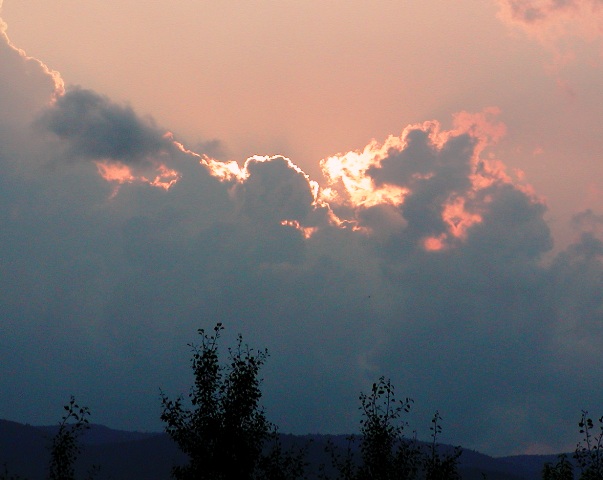
I mostly finished detailing the carving around the rear ramrod pipe. I will come back and clean it up a little more and add a detail or so later.
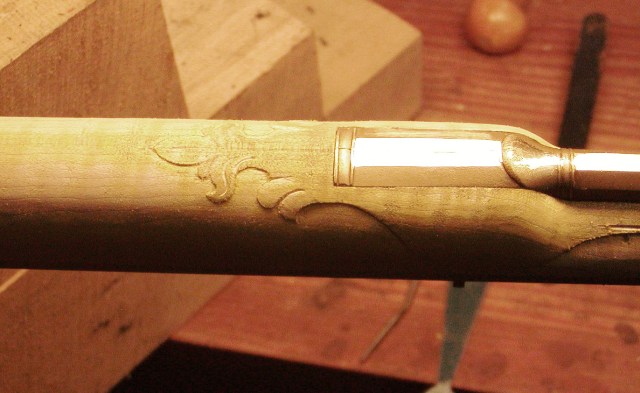
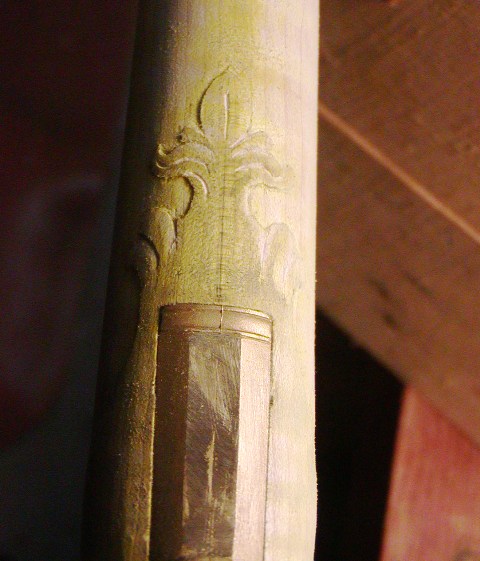
I scraped and sanded the fore stock to final finish but I decided to add a double line border to the ramrod channel molding. This is a very simple device but it adds a great deal of sophistication to the molding. I start by using a Gunline 60 degree parallel line cutter to scribe the line.
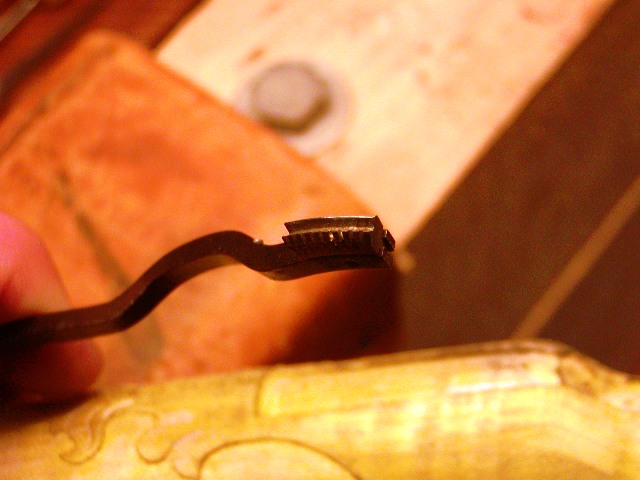
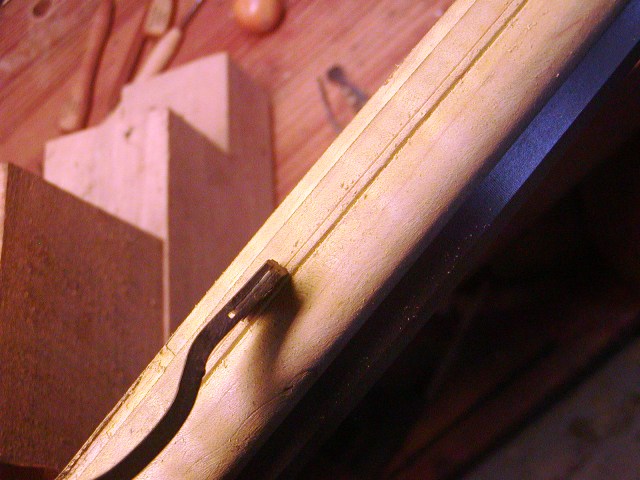
Then I deepen the line with a Gunline 60 degree single line cutter after which I widen it a bit with a Dembart 90 degree border tool.
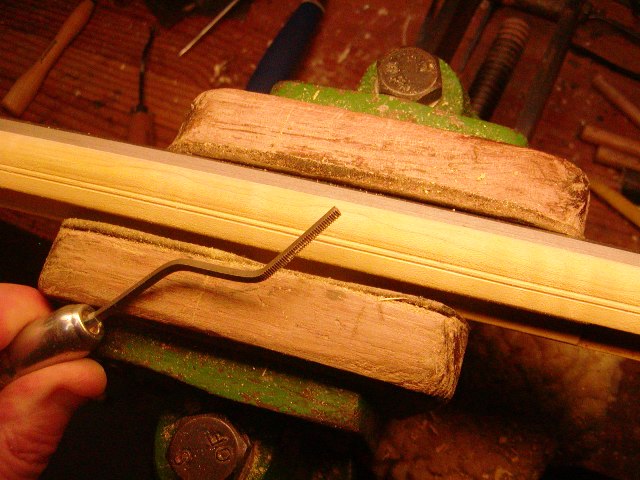
The result is a really nice border that enhances the fore stock molding greatly.
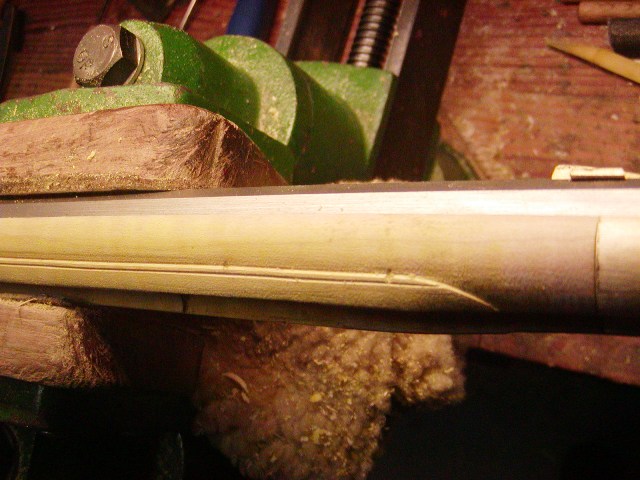
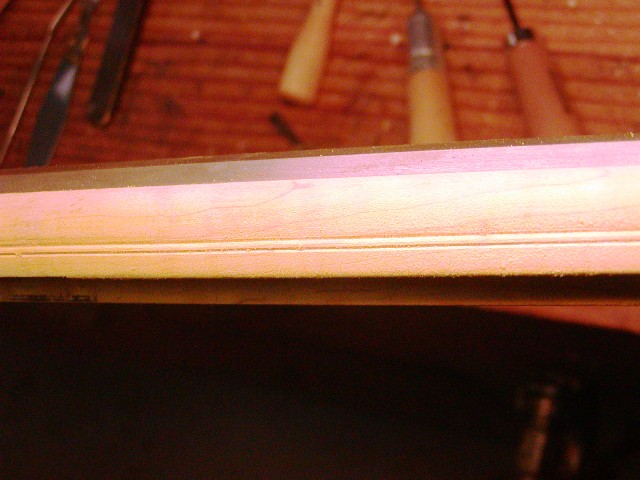
Simple borders like this dress up any stock and any engraving. They are worth learning to do well and if you never do anything more complicated, you will accomplish a lot by just learning to do simple borders.
dave
Had a very good productive day, although only a small portion was devoted to gun building. I was working on a scientific paper that gets my thinking cap going in a different direction. First, I thought I would show you a cloud picture I took this month that was the inspiration for the wire work behind the cheek piece. This is what got me thinking and designing the clouds. I translated that feeling from this image into folk art:

I mostly finished detailing the carving around the rear ramrod pipe. I will come back and clean it up a little more and add a detail or so later.


I scraped and sanded the fore stock to final finish but I decided to add a double line border to the ramrod channel molding. This is a very simple device but it adds a great deal of sophistication to the molding. I start by using a Gunline 60 degree parallel line cutter to scribe the line.


Then I deepen the line with a Gunline 60 degree single line cutter after which I widen it a bit with a Dembart 90 degree border tool.

The result is a really nice border that enhances the fore stock molding greatly.


Simple borders like this dress up any stock and any engraving. They are worth learning to do well and if you never do anything more complicated, you will accomplish a lot by just learning to do simple borders.
dave
Exquisite! This belongs in a museum.
- Joined
- Sep 24, 2008
- Messages
- 609
- Reaction score
- 854
Agreed! How about MY museum?
Appalachian Harry
36 Cl.
- Joined
- Jul 28, 2021
- Messages
- 71
- Reaction score
- 32
Such awesome carvings!!!
Simple does not mean easy. An expert makes it look easy, but it is years of dedicated practice that are at work. It is inspiring to watch how it’s done!
- Joined
- Nov 26, 2005
- Messages
- 5,247
- Reaction score
- 11,028
Hi,
I finished up the carving and did final scraping and clean up before stain. It is very important to shine a single source light on the stock at low angles to show up the rough spots and imperfections. This is critical with light colored woods like maple and cherry. You will always find spots that you thought were fine that still have rough areas or depressions and scratches. I used 220 grit sandpaper, a carpet scraper blade and scary sharp skew chisels to clean up. I also added a few decorative details to highlight some features and fill in other blank spaces. I added a double line border to the fore arm along with 3 dots, a bit like the wire inlay around the patch box. I added a cross hatched area at the base of the rear ramrod pipe tang, and a few decorative "V" shaped notches here and there.
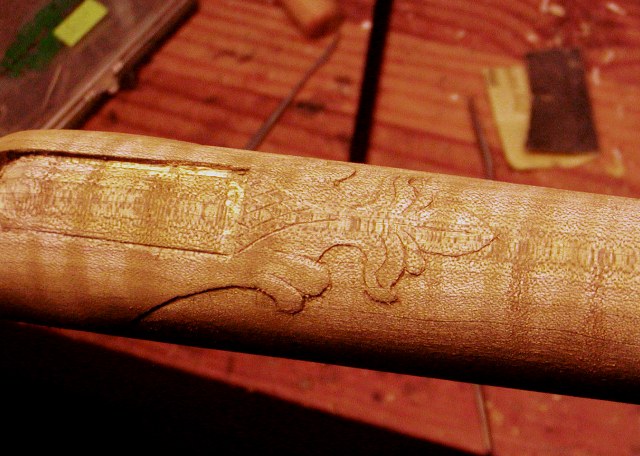
I also tested stains on some scrap curly maple. The last task was to use my flat checkering single cutter and small "V" chisels to go around the edges of the carving and cut very slight incising. That will make the carving pop. Also, I fully expect that I will go back after staining and find a few places needing clean up. I'll clean them up, touch up the stain and then go on to the finish. One disadvantage to the Kibler kit is you don't have any scrap wood from the stock to test stains. You can use the barrel channel or the inside of the patch box cavity but it is not the same as having a large piece of stock to work with. I have a lot of good hard curly maple scraps and decided to use those realizing that the Kibler stock may perform slightly differently, slightly I hope.
I mostly use ferric nitrate crystals purchased online from the Science Company and dissolved in water as my stain for maple. This creates the same chemical solution as what most of you know as "aqua fortis". Actually, aqua fortis is simply the ancient name for nitric acid (loud water) but most of you think of it as a stain made from iron dissolved in the acid. Ferric nitrate and water create the same liquid but with much less acidity and it usually works great on woods such as maple and birch. I used a weak solution of 1 part ferric nitrate crystals to 12 parts water by volume. However on test wood it was not as orangey red as I wanted. I wanted to boost the red without significantly darkening the color, which tends to happen if I simply increase the concentration of ferric nitrate. What works in that case is I add a few squirts of 10% nitric acid solution (purchased with no problems online from the Science Company) to the ferric nitrate stain and a little bit of steel wool. I let it sit overnight and paint the stock the next day. This usually gives me a redder color but does not darken the browns that much. I am not sure why it works differently than simply increasing the concentration of ferric nitrate but it does. I paint the stock with the stain, let it dry thoroughly, and then blush it with a heat gun. The stain dries to an ugly gray color but when blushed with a heat gun or propane torch, it turns a nice reddish brown. After blushing, I neutralize the acid by painting the stock with lye mixed in water. This not only neutralizes the acidity but turns the color more reddish.
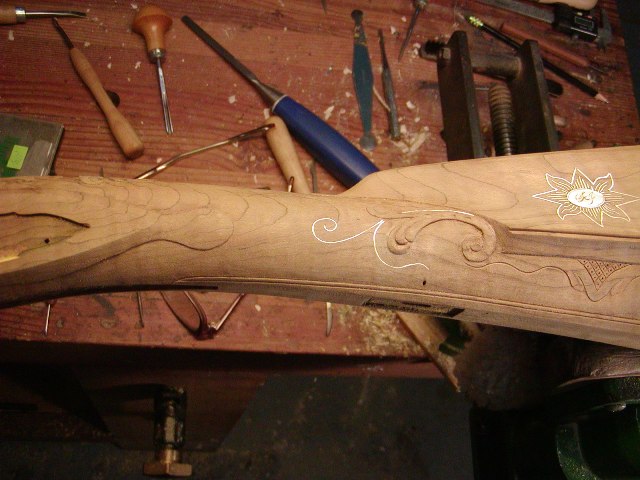
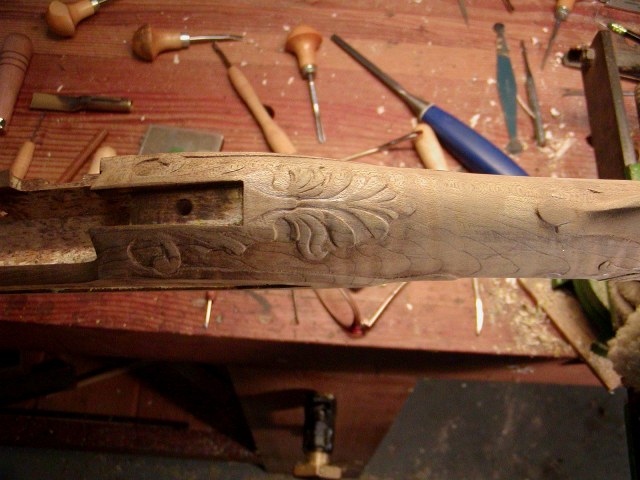
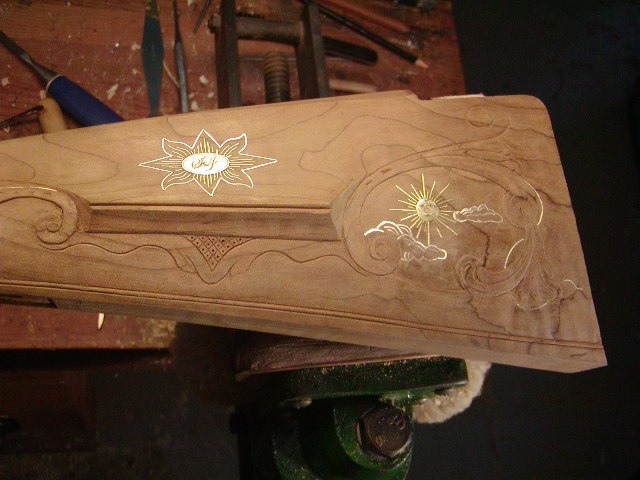
The result was almost there but I wanted still a little more orangey red. So I mixed a weak stain from recorcin brown, scarlet, and orange aniline dyes dissolved in water. I tested it on scrap wood and finally got exactly what I wanted. Subsequently I painted the stock. I think it is going to look really good.
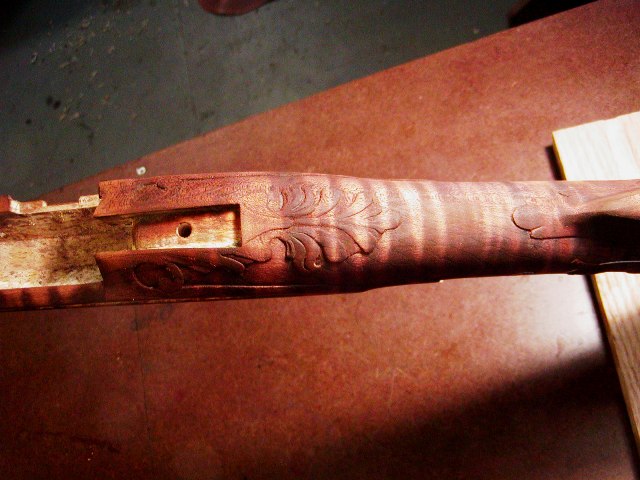
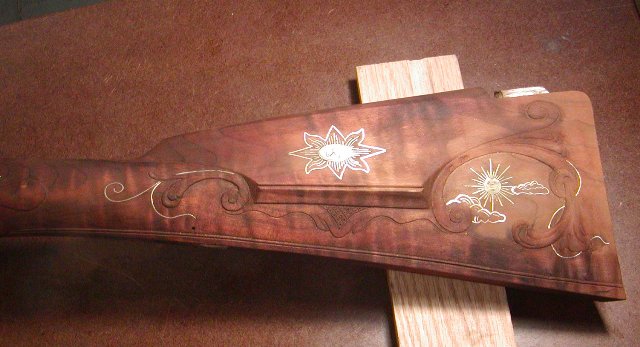

I will inspect the stock closely, then put the gun together again to make sure everything fits as it should, then take it apart and put finish on . I may wait a few days until we have warm dry weather so I can put the stock outside in the sun.
dave
I finished up the carving and did final scraping and clean up before stain. It is very important to shine a single source light on the stock at low angles to show up the rough spots and imperfections. This is critical with light colored woods like maple and cherry. You will always find spots that you thought were fine that still have rough areas or depressions and scratches. I used 220 grit sandpaper, a carpet scraper blade and scary sharp skew chisels to clean up. I also added a few decorative details to highlight some features and fill in other blank spaces. I added a double line border to the fore arm along with 3 dots, a bit like the wire inlay around the patch box. I added a cross hatched area at the base of the rear ramrod pipe tang, and a few decorative "V" shaped notches here and there.

I also tested stains on some scrap curly maple. The last task was to use my flat checkering single cutter and small "V" chisels to go around the edges of the carving and cut very slight incising. That will make the carving pop. Also, I fully expect that I will go back after staining and find a few places needing clean up. I'll clean them up, touch up the stain and then go on to the finish. One disadvantage to the Kibler kit is you don't have any scrap wood from the stock to test stains. You can use the barrel channel or the inside of the patch box cavity but it is not the same as having a large piece of stock to work with. I have a lot of good hard curly maple scraps and decided to use those realizing that the Kibler stock may perform slightly differently, slightly I hope.
I mostly use ferric nitrate crystals purchased online from the Science Company and dissolved in water as my stain for maple. This creates the same chemical solution as what most of you know as "aqua fortis". Actually, aqua fortis is simply the ancient name for nitric acid (loud water) but most of you think of it as a stain made from iron dissolved in the acid. Ferric nitrate and water create the same liquid but with much less acidity and it usually works great on woods such as maple and birch. I used a weak solution of 1 part ferric nitrate crystals to 12 parts water by volume. However on test wood it was not as orangey red as I wanted. I wanted to boost the red without significantly darkening the color, which tends to happen if I simply increase the concentration of ferric nitrate. What works in that case is I add a few squirts of 10% nitric acid solution (purchased with no problems online from the Science Company) to the ferric nitrate stain and a little bit of steel wool. I let it sit overnight and paint the stock the next day. This usually gives me a redder color but does not darken the browns that much. I am not sure why it works differently than simply increasing the concentration of ferric nitrate but it does. I paint the stock with the stain, let it dry thoroughly, and then blush it with a heat gun. The stain dries to an ugly gray color but when blushed with a heat gun or propane torch, it turns a nice reddish brown. After blushing, I neutralize the acid by painting the stock with lye mixed in water. This not only neutralizes the acidity but turns the color more reddish.



The result was almost there but I wanted still a little more orangey red. So I mixed a weak stain from recorcin brown, scarlet, and orange aniline dyes dissolved in water. I tested it on scrap wood and finally got exactly what I wanted. Subsequently I painted the stock. I think it is going to look really good.



I will inspect the stock closely, then put the gun together again to make sure everything fits as it should, then take it apart and put finish on . I may wait a few days until we have warm dry weather so I can put the stock outside in the sun.
dave
- Joined
- Nov 26, 2005
- Messages
- 5,247
- Reaction score
- 11,028
Hi Simon'
There have been 3 papers, one on predator control in Alaska, one on Sitka black-tailed deer habitat selection, and the third on wolf population viability on a large island in SE Alaska. Gun work, papers, and acting as a science advisor for wildlife agencies in Maine and Vermont, added to maintaining my place in Vermont and taking care of a border collie pretty much fills in all of my time and then some.
There have been 3 papers, one on predator control in Alaska, one on Sitka black-tailed deer habitat selection, and the third on wolf population viability on a large island in SE Alaska. Gun work, papers, and acting as a science advisor for wildlife agencies in Maine and Vermont, added to maintaining my place in Vermont and taking care of a border collie pretty much fills in all of my time and then some.
Rudall
40 Cal
When you are doing relief carving on something that is essentially already finished, how much of the surrounding wood (border area, not depth) do you have to take down to provide the relief thickness? How do you do that? With finger planes, chisels, scrapers?
Brokennock
Cannon
- Joined
- Nov 26, 2005
- Messages
- 5,247
- Reaction score
- 11,028
Hi Rudall and Brokennock,
You want a stock to be almost finished before starting carving and that includes any moldings around the lock or along the ramrod channel. Most carving is only 1/32-1/16" high so the relief is low. Moreover, you create more relief by combining the above surface carving with incised cuts going below the surface. The height is an illusion and is be accentuated by the stain. If you view page 4 of this thread, I show how I relieve the background.
dave
You want a stock to be almost finished before starting carving and that includes any moldings around the lock or along the ramrod channel. Most carving is only 1/32-1/16" high so the relief is low. Moreover, you create more relief by combining the above surface carving with incised cuts going below the surface. The height is an illusion and is be accentuated by the stain. If you view page 4 of this thread, I show how I relieve the background.
dave
Rudall
40 Cal
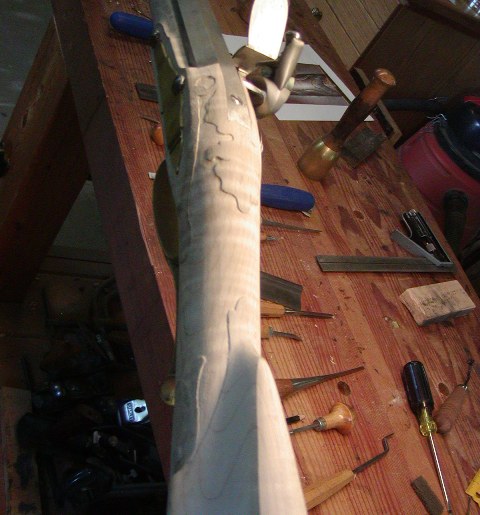
So for example, in the pic above what is the situation between the relief behind the tang and the relief in front of the comb? Is most of that the original level, or was it all taken down by the 1/32 or 1/16 that the relief is proud of the surface?
Thank you.
- Joined
- Nov 26, 2005
- Messages
- 5,247
- Reaction score
- 11,028
Hi,
The surface of the stock was removed with a carpet scraper blade between the tang and comb carvings because if I just dived into the wood at the edges of the carving, that dip would show in the profile of the stock. However, in the situation below, between the butt plate and the carving, the surface of the wood angles down toward the carving so the whole area was not relieved. That is a spot where doing that is not detectable unlike the wrist.
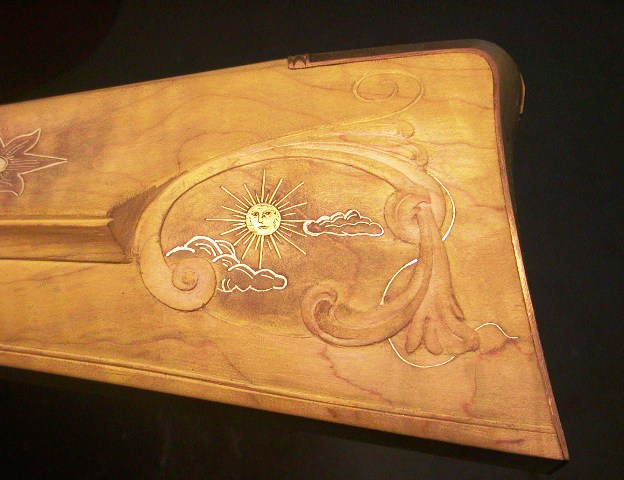
A lot depends on where the carving is but in most cases, the entire surface bordering the carving must be relieved and that is done with scrapers, files, and skew chisels mostly.
dave
The surface of the stock was removed with a carpet scraper blade between the tang and comb carvings because if I just dived into the wood at the edges of the carving, that dip would show in the profile of the stock. However, in the situation below, between the butt plate and the carving, the surface of the wood angles down toward the carving so the whole area was not relieved. That is a spot where doing that is not detectable unlike the wrist.

A lot depends on where the carving is but in most cases, the entire surface bordering the carving must be relieved and that is done with scrapers, files, and skew chisels mostly.
dave
Rudall
40 Cal
That makes things much clearer. Thank you very much.
Not that I’m ever going to do it!
Not that I’m ever going to do it!
Brokennock
Cannon
Thank you.Hi,
The surface of the stock was removed with a carpet scraper blade between the tang and comb carvings because if I just dived into the wood at the edges of the carving, that dip would show in the profile of the stock. However, in the situation below, between the butt plate and the carving, the surface of the wood angles down toward the carving so the whole area was not relieved. That is a spot where doing that is not detectable unlike the wrist.

A lot depends on where the carving is but in most cases, the entire surface bordering the carving must be relieved and that is done with scrapers, files, and skew chisels mostly.
dave
What about the acid's effect, or lack thereof, on the soft metals?
- Joined
- Nov 26, 2005
- Messages
- 5,247
- Reaction score
- 11,028
Hi,
The acid tarnishes the brass but barely touches the silver. The tarnish is easily polished off. After the acid stain dries and is blushed with heat, theoretically all the hydrogen ions (the acid part) are driven off leaving ferric oxide (rust) bonded with the wood fiber. However, just to be sure, I coat the stock with lye mixed in water, or baking soda mixed in water, or ammonia. Something basic with regards to PH. That assures all acidity is neutralized. The use of nitric acid based stains goes back at least to the 1200s and probably earlier.
dave
The acid tarnishes the brass but barely touches the silver. The tarnish is easily polished off. After the acid stain dries and is blushed with heat, theoretically all the hydrogen ions (the acid part) are driven off leaving ferric oxide (rust) bonded with the wood fiber. However, just to be sure, I coat the stock with lye mixed in water, or baking soda mixed in water, or ammonia. Something basic with regards to PH. That assures all acidity is neutralized. The use of nitric acid based stains goes back at least to the 1200s and probably earlier.
dave
- Joined
- Nov 26, 2005
- Messages
- 5,247
- Reaction score
- 11,028
Hi,
Thank you all for your comments, encouragement, and interest. I appreciate it very much. Exciting day! The first coat of finish is always a milestone. Does the color come out the way you intended? Well, it did. The bright directional light does not show it off very well but I think you can get a sense of what the stock will look like. This is only the base because I will use bone black to create shading and accents.
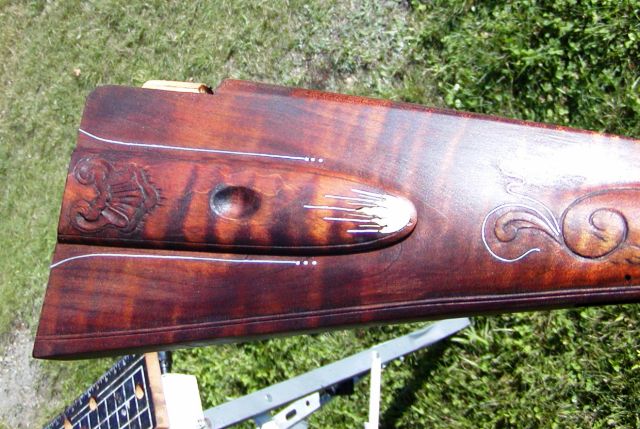
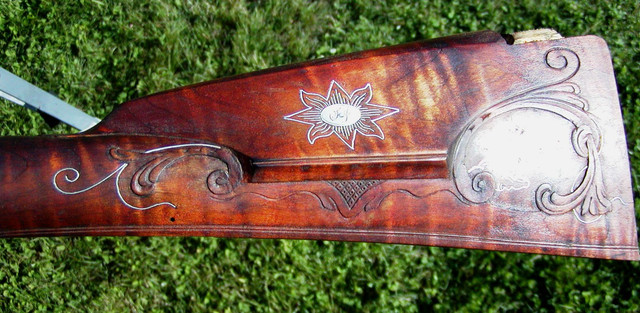
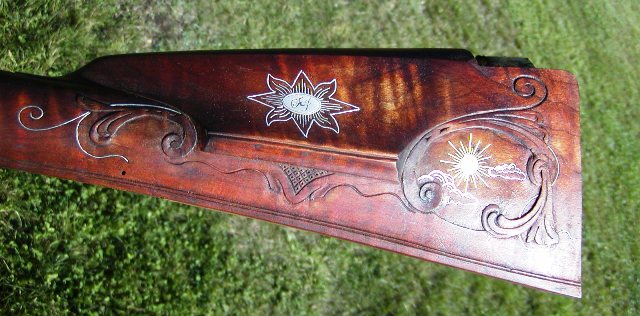
dave
Thank you all for your comments, encouragement, and interest. I appreciate it very much. Exciting day! The first coat of finish is always a milestone. Does the color come out the way you intended? Well, it did. The bright directional light does not show it off very well but I think you can get a sense of what the stock will look like. This is only the base because I will use bone black to create shading and accents.



dave
- Joined
- Nov 26, 2005
- Messages
- 5,247
- Reaction score
- 11,028
Hi Folks,
Thanks again everyone for your interest. The boring part is happening now as I add finish and wait for it to dry. I am cleaning up the brass, which is easy with files and sandpaper. Jim Kibler's brass alloy is very nice and files easily unlike some of the wax cast components you get from TOW. It also has a nice yellow brass color that matches the many originals. I installed a taller rear sight than the one that came with the kit. It is a standard cast sight sold by TOW and others and it stands over 1/4" high above the barrel. The owner is tall so the higher sight may fit him better. Regardless, he will still have the low rear sight that came with the rifle and both fit the dovetail exactly. I normally have to work over and tune the locks and would post that process but not on this gun so that part is excluded. I am going to engrave my script name and block letters "Braintree Hill" the name of my gun shop on the barrel. If there is some interest in how to do that, I'll post some photos otherwise, I'll probably not post any until the rifle is finished.
dave
Thanks again everyone for your interest. The boring part is happening now as I add finish and wait for it to dry. I am cleaning up the brass, which is easy with files and sandpaper. Jim Kibler's brass alloy is very nice and files easily unlike some of the wax cast components you get from TOW. It also has a nice yellow brass color that matches the many originals. I installed a taller rear sight than the one that came with the kit. It is a standard cast sight sold by TOW and others and it stands over 1/4" high above the barrel. The owner is tall so the higher sight may fit him better. Regardless, he will still have the low rear sight that came with the rifle and both fit the dovetail exactly. I normally have to work over and tune the locks and would post that process but not on this gun so that part is excluded. I am going to engrave my script name and block letters "Braintree Hill" the name of my gun shop on the barrel. If there is some interest in how to do that, I'll post some photos otherwise, I'll probably not post any until the rifle is finished.
dave
appalichian hunter
75 Cal.
- Joined
- Oct 28, 2018
- Messages
- 5,828
- Reaction score
- 9,477
Looking good.
Similar threads
- Replies
- 18
- Views
- 2K
- Replies
- 52
- Views
- 4K



